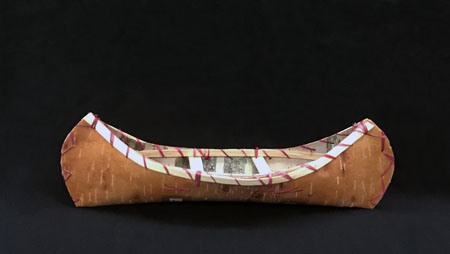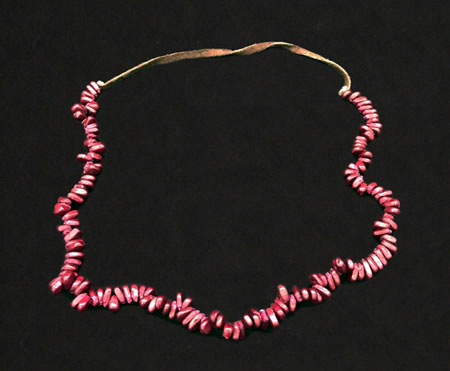Three copies of the Woodland Culture Area Kits are available for checkout. Each kit contains a teacher guide as well as accompanying books and artifacts about transportation, material culture, and foods. Below are some images and labels about some of the artifacts in the kit.
Birch Bark Canoe
This is a miniature version of th ebirchbark canoes made by the people of the Woodland culture area. Birchabrk's unusual strenth and light weight made it an ideal material for canoes. The bark was taken from the birch trees in early spring becuase that is when the bark peels most easily and the tree will not be harmed. The frame of the canoe is made of spruceroot. The birchbark was then cut and shaped to fit around the frame. Real canoes varied in size from two person river canoes about 12 feet in length to 35 foot canoes which could hold 8 people and were used for traveling on the Great Lakes. Modern canoes of today are very similar to these Woodland canoes.

Corn Necklace
Corn was not only used for food by the people of the Woodland culture area. It was also used for decorative purposes. This corn necklace consists of many kernels of corn, some of which have been dyed a deep red. They have been strung with a needle and thread when they were stil soft and then allowed to dry before wearing. Corn was very important to the Woodland people. It was often grown in a field together with beans and squash. These three vegetables were called "The Three Sisters."

Woodland Moccasin
This moccasin is made from deer hide that has been tanned using traditional methods. The hide is scraped on the outside to remove hair from the deer and on the inside to remove the meat. It is then softened, washed with water, and scraped some more to break down the fiber of the hide. The last step in preparting the hide is to hang it up and smoke it over an alderwood fire. The hide is then ready to be used for clothing, such as these moccasins. Different tribes constructed their moccasins in different ways. Therefore the moccasins from each tribe left a distinct footprint. Long ago, a person from this culture are could look at footprints in the woods and tell what tribe the person was from by the imprint the moccasin had made.

